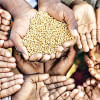Global Hunger Index: Country does better than India, Pakistan
Bangladesh has ranked 88th out of 117 qualifying countries on the Global Hunger Index (GHI) 2019 with a score of 25.8, which is higher than India and Pakistan.
Pakistan ranked 94th with a score of 28.5 while India ranked 102nd with a score of 30.3 in terms of severity of hunger, according to the GHI report 2019, available on its website.
The country with the severest problem of hunger at rank 117 of the index is the Central African Republic.
The GHI calculates the levels of hunger and undernutrition worldwide. The four indicators for the index are undernourishment, child stunting, child wasting and child mortality.
Concern Worldwide and Welthungerhilfe jointly publish the GHI report every year to comprehensively measure and track hunger at the global, regional, and country levels and trigger action to reduce hunger around the world.
According to the report, India’s GHI indicator values have an outsized impact on the indicator values for the South Asian region. India’s child wasting rate is extremely high at 20.8 percent, the highest wasting rate of any country in this report for which data or estimates were available. Its child stunting rate, 37.9 percent, is also categorised as very high in terms of its public health significance.
Outside of India, two countries in South Asia have made significant advances in child nutrition, and their experiences are instructive. A 2015 study sought to identify the reasons behind the decline in stunting in Bangladesh at the national level from 58.5 percent in 1997 to 40.2 percent in 2011.
The study attributed the decrease primarily to rising household wealth associated with pro-poor economic growth and gains in parental education, as well as health, sanitation, and demographic factors reflecting decreased fertility rates.
The authors conclude that success in this area can be achieved with robust economic growth and attention to “nutrition-sensitive” sectors such as education, sanitation, and health.
Nepal’s remarkable reduction in child stunting from 56.6 percent in 2001 to 40.1 percent in 2011 is associated with, and likely attributable to, increased household assets (a proxy for household wealth), increased maternal education, improved sanitation, and implementation and use of health and nutrition programmes, including antenatal and neonatal care.
However, the 2019 GHI indicates that the level of hunger and undernutrition worldwide falls on the cusp of the moderate and serious categories, at a value of 20.0. This value reflects a decline in the global GHI score in each period examined since 2000, when the global GHI score was 29.0 and fell into the serious category.
The achievement coincides with a decline in poverty at the global level from 28.6 percent in 1999 to 9.9 percent in 2015, the report said, adding that the poverty and hunger are closely correlated.

 For all latest news, follow The Daily Star's Google News channel.
For all latest news, follow The Daily Star's Google News channel. 




Comments